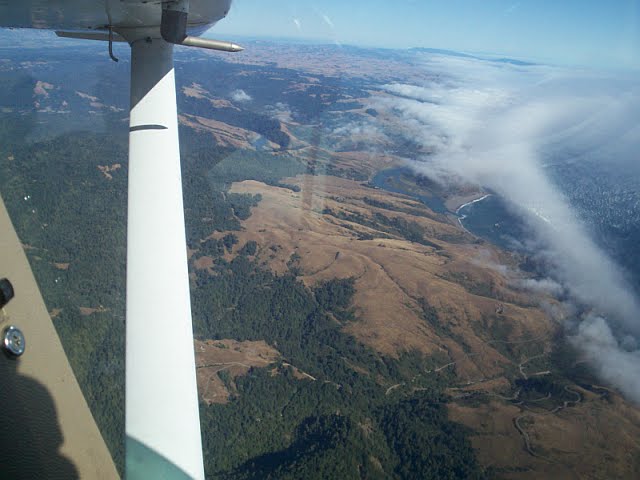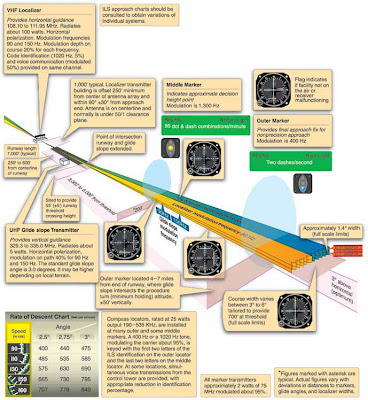I tell myself to, "relax, have fun and don't forget to breathe" but it's not helping much.
I am on my way to Santa Rosa Airport (STS) to fly my IFR long cross country flight. It has been planned and canceled three times. For this reason I have spent a significant amount of time planning and mentally preparing for this flight.
At this point in my training I have 20 hours under the hood and I feel as if I should be more than ready. I know the plane, I know the flight plan, I know the approaches so there should be few surprises, right? Wrong.
After this flight I have a new mnemonic that will become part of every IFR flight plan - NAP. Not As Planned.
First off, I make a fundamental mistake. I forget to file an alternate, even though my first point of intended landing was below the 1-2-3 requirements. How did I miss this in all my "careful" planning? This mistake gnaws at me because I realize how serious it is. "May I have some more anxiety, please sir?".
Secondly, right after I finished my pre-flight and declare the plane airworthy, my flight instructor says, "The right wing looks a little low,"
The wing looks a little low? What the hell is he talking about? I stand back and look at the plane. I have to admit that the right wing does look low. A head measurement confirms it. FYI - a head measurement is when you walk up to the wing and bang your head into it. Then you go to the same point on the other wing and bang your head again. If one bruise is lower than the other, and you know you are on level ground, then something's rotten in Denmark.
I pull out the tire pressure gauge and check the right tire. It's quite a bit low, though it did not look very low. Mental note - an aircraft tire that looks a little low may be a LOT low in reality. I'm still skeptical that this is going to level the wings, however.
Of course the compressed air tank that we keep in the hangar for this reason turns out to be empty. NAP.
I carry a portable air compressor in my car and in a few minutes the tire is full and, low and behold, the damn wings are now level. Add a new pre-flight checklist item - are the wings level?
I find myself getting a little more tense as a result of this confusing delay.
It seems every IFR flight ends up being "NAP". This seems contradictory to me VFR experience. When you plan a flight VFR there are primarily two outcomes - either you fly the plan or you just don't go. Occasionally you will have to divert en route, by rarely.
Yet every IFR flight I make seems to go NAP at some point in the process. This seems to be the hardest part of flying IFR for me.
On one hand, IFR requires rigid planning and attention to every detail. On the other hand, I have learned to expect ATC to change my "rigid plan" before I've completed the departure procedure. Today is no different.
I realize some of the following ATC changes are minor and, in fact, save time. Yet as an IFR student sometimes I just want to fly the route I planned and filed. This would allow me to do things in the order I am expecting with the available time I am expecting.
I am just off STS climbing in the Frees6 departure procedure when ATC clears me "direct Santa Rosa, then as filed." Ok, quick, forget all about the Frees departure, figure out whether to make a left or right hand turn and figure out which heading will take you directly back to Santa Rosa. While your at it maintain your climb rate and airspeed. ATC has thrown me into mental gymnastics and I'm barely off the ground. NAP.
We leave Santa Rosa behind and flying V301 we head into the Central Valley bound for my next fix, Williams VOR. Of course, ATC will not let me fly to the VOR. That would be too simple.
 |
| The view over the Central Valley approaching Marysville VOR |
"34777, cleared direct Marysville VOR," ATC orders.
"Blow me, Cardinal 34777", I feel like responding. NAP
Leaving the Marysville VOR, the VOR approach into Oroville (OVE) is pretty straight forward. I fly it without any major screw ups. The plan is to go "missed" and then pick up the second leg of our flight up to Redding.
I am in a climbing left turn on the missed approach when something in my scan is not right. My turn coordinator has died. NAP.
 |
| So much for standard rate turns today... |
It is VFR conditions. I quickly cover the gauge with a post-it. Yet, for some reason this equipment failure increases my anxiety. I remind myself to breath and focus on hte next leg of the flight. This would be V23 to Red Bluff after I reach the Talum intersection. Well, it was supposed to be but, of course, ATC has other ideas.
"34777 cleared direct Red Bluff", says ATC.
I should be expecting this by now. Once I have my IFR rating, and am on a real flight somewhere, I will appreciate this kind routing change. It will save me time and fuel. Today, however, I don't appreciate the consideration.
The ILS Runway 34 at Redding is fairly simple without a bunch of step-down fixes. I fly it well and make a decent landing.
We pull up to the Redding Jet Center for fuel and a potty break. The jet center is a little more upscale than I would have expected and it's a nice place to take a break.
 |
| Fueling at Redding Jet Center |
I have filed the Homan 2 departure to RBL, V87 down to RUMSY and the V301 to STS. However, once in the air we will request a diversion to Ukiah so that I can fly the Localizer Runway 15. This will meet the requirement for three different approaches.
Surprisingly, I am able to fly the complete plan without any changes. My approach does not go so well. I neglect to account for the tail wind, don't start the timer until late and the combination of the two leaves me directly over Ukiah's runway 15 at the timed point. I would not have been able to make a normal approach to land.
Fortunately the IFR cross country requirements only require me to "fly" three approaches. They don't have to be good ones. Honestly, instead of feeling disappointed in myself over this approach, all I can think of getting out of the plane. Nearly four hours of flying under the hood has worn me out.
I'm hoping my instructor will let me take off the view limiting device and let me fly visual but that doesn't happen. He cancels IFR but continues to give me heading and altitude changes all the way back to STS. My landing is ok and as I start to taxi to the hangar I start to realize just out physically drained I feel. This has been a difficult mental exercise for me. It has made me realize how far I still have to go before I am truly ready to call myself an IFR pilot.
Lessons Learned
- Every IFR flight will end up NAP in some way or another. Plan rigidly but be prepared for deviations at any point in the flight.
- I was not pleased with my heading control. While most of the time I am within the required test standards, that's not good enough. I need to learn to make corrections sooner as well as avoiding heading changes while looking away from the primary gauges (looking at charts, adjusting the GPS, etc.).
- Do a final flight plan the morning of the flight and verify whether or not an alternate is, or may be required, required. It doens't hurt to file an alternate, just in case.
- If the tire looks a little low, take a look at the wings. If they don't look level it's a good chance the tire is really low.
- Be aware of a tail wind on an approach and slow down accordingly. Check the GPS to verify your ground speed is not exceeding the desired approach speed. Keeping the GPS set for nautical miles instead of statute miles will help with this.
The Positive Side
- I felt in control of the flight. I did not get mentally lost and require my instructor to bail me out.
- Two of my three approaches were flown well.
- I dealt with the failure of the turn coordinator without it being a major distraction.
- I handled almost all ATC communications with very little help from my instructor.
- The noise-canceling Lightspeed headsets my instructor loaned me are so much quieter and moire clear than my DC 13.4s. They are now on my wish list.
Some Final Stats For the Flight
Total time on tach: 3.5 hours
Total cost of flight including instructor, fuel and club charges: $537.42
Maximum altitude: 9000 feet
Maximum air speed: 160 MPH
Total duration of flight, including fuel/pee stop: 5 hours
Approaches flown: OVE VOR; RDD ILS Rwy 34; UKI Loc Rwy 15
Approximate air miles flown: 340 nautical miles
Total fuel consumption: 32.9 gallons
Average fuel burn: 9.4 gallons per hour














